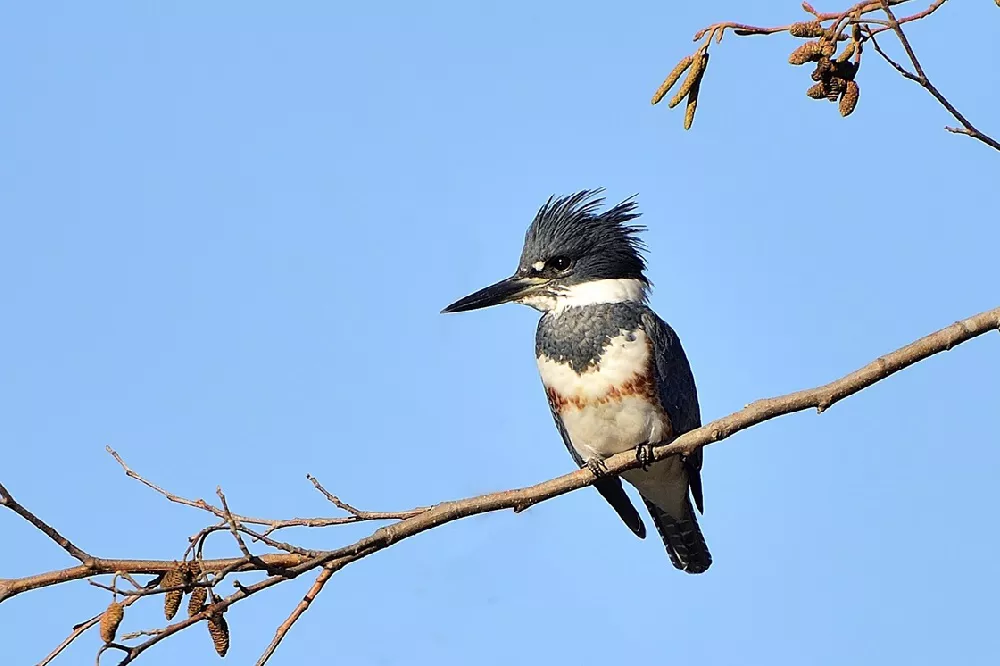The Belted Kingfishers (Megaceryle alcyon) are striking birds that are widely distributed throughout North America. They are known for their distinctive blue-grey plumage with a white collar and a shaggy crest on the head. These birds are commonly spotted near freshwater sources such as rivers, lakes, or streams where they dive into the water to catch fish. While their hunting prowess is well-known, many people wonder about the lifespan of these fascinating birds. In this article, we explore the average lifespan of Belted Kingfishers and shed light on the factors that influence their longevity.
Overview of the Belted Kingfisher:
The Belted Kingfisher is a medium-sized bird with a stocky build, large head, and a long, pointed bill. It exhibits remarkable sexual dimorphism, with males featuring a blue-gray upper body and a white underbelly, while females sport a chestnut-colored band across their lower belly. Both genders boast a distinctive shaggy crest atop their heads. Belted Kingfishers are primarily piscivorous, meaning they feed on fish, but they may also consume crustaceans, amphibians, insects, and small mammals.
Average Lifespan of the Belted Kingfisher:
The lifespan of Belted Kingfishers is subject to considerable variation, influenced by a range of factors such as predation, habitat quality, and individual health. On average, these birds have a lifespan of around 6 to 10 years in the wild. However, there have been documented cases of Belted Kingfishers living up to 15 years in the wild, showcasing their potential for longevity.
In captivity, Belted Kingfishers can live for much longer than in the wild. The oldest known Belted Kingfisher in captivity lived to be 21 years old! Captive Belted Kingfishers typically live longer than their wild counterparts because they have access to a consistent supply of food, clean water, and medical care.
Factors Affecting Lifespan:
Predation: Belted Kingfishers face predation from various sources, including larger birds of prey, such as eagles and hawks, as well as terrestrial predators like raccoons and snakes. Increased predation pressure can significantly impact the lifespan of these birds, particularly in areas with high predation rates.
Habitat Quality: The availability of suitable habitats and foraging grounds plays a crucial role in determining the lifespan of Belted Kingfishers. Degraded or polluted water bodies can impact their food sources and overall health. Human activities, such as habitat destruction and pollution, can adversely affect the longevity of these birds.
Disease and Health: Like any living organism, Belted Kingfishers are susceptible to various diseases, including avian parasites and infections. Poor health conditions and compromised immune systems can shorten their lifespan. Environmental factors, such as exposure to pollutants or contaminated food, may also impact their overall health.
Accidental Threats: Belted Kingfishers face accidental threats, such as collisions with vehicles or structures, which can result in fatal injuries. These birds frequently fly low over water bodies during their hunting flights, increasing the risk of collision with power lines or other obstacles.
How to increase the lifespan of belted kingfishers:
There are several ways to help increase the lifespan of belted kingfishers. One of the most important ways is to preserve their natural habitat. This can be achieved by reducing pollution levels, protecting wetlands, and preserving riparian areas.
Another way to increase their lifespan is to minimize the risk of predation. Installing predator-proof nest boxes can help protect young birds from predators. Additionally, planting native vegetation in yards and gardens can provide cover and food sources for belted kingfishers, reducing their vulnerability to predators.
Conservation Significance:
Understanding the lifespan of Belted Kingfishers is crucial for conservation efforts aimed at protecting their habitats and ensuring their long-term survival. Conservation initiatives should focus on preserving and restoring healthy aquatic ecosystems, reducing pollution, and minimizing human disturbances to their habitats.
Conclusion:
In conclusion, Belted Kingfishers have a relatively short lifespan in the wild, typically living for around 5 to 10 years. However, some individuals can live for up to 15 years. Habitat loss is a major threat to Belted Kingfishers, and human activities have contributed to declines in populations and reduced lifespans. In captivity, Belted Kingfishers can live much longer, with the oldest known individual living to be 21 years old.
Related Topics:
- Where Do Belted Kingfishers Live?
- What Do Belted Kingfishers Eat?
- What Does a Belted Kingfisher Sound Like?


 Facebook
Facebook  Instagram
Instagram  Youtube
Youtube 